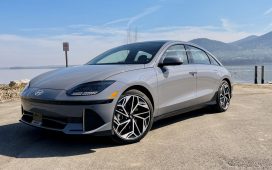General Motors is getting rid of the “Ultra Cruise” brand and merging the team that was working on it with the team responsible for Super Cruise, as the automaker reconsiders its goals for advanced driver-assist systems (ADAS).
Last week, CNBC reported that GM was “ending the Ultra Cruise program,” focusing instead on the current Super Cruise system that is available across the company’s vehicle lineup. GM spokesperson Aimee Ridella clarified that the ultimate intention is to improve Super Cruise but that no one is being laid off as a result of this decision.
“GM is not scaling back its advanced driver assistance programs,” Ridella said in an email. “We have reallocated our ADAS-focused resources to bring even more capability to Super Cruise under one recognizable consumer brand.”
“GM is not scaling back its advanced driver assistance programs.”
GM first announced Ultra Cruise during an investor event in 2021, describing it as a massive leap over the company’s Super Cruise system, which allows for hands-free driving on mapped divided highways. In contrast, Ultra Cruise will cover “95 percent” of driving scenarios on 2 million miles of roads in the US, the company said.
The subtext was that GM wanted a system that rivaled Tesla’s Full Self-Driving, which is a Level 2 system that allows for hands-free driving on surface roads but still requires the driver to take control if required. Even though Tesla has been criticized for rolling out a beta version of its ADAS before it was actually ready, GM clearly thought that a next-generation hands-free driving system was worth pursuing.
As defined by SAE International, a Level 2 system can control steering, acceleration, and deceleration as well as monitor blind spots and even change lanes automatically. But the driver needs to stay vigilant and keep their eyes on the road; if they don’t, the vehicle’s driver monitoring system will theoretically detect it, and the system will send several warnings to the driver before disengaging.
First introduced in 2017, Super Cruise was GM’s first foray into hands-free driving. The system relies on a detailed map of the highway system, which are the only roads where it can be activated.
Now that Super Cruise is the dominant — and only — ADAS brand in GM’s portfolio, the automaker is revising its goals for partial automation. That includes reevaluating the goal of trying to achieve hands-free driving for 95 percent of scenarios as well as which sensors will be necessary to achieve these aims.
Previously, GM outlined several of the sensors that will power the driver-assist system, including cameras, short- and long-range radar, and a lidar sensor. GM has said its vehicles will come with Qualcomm’s new Snapdragon Ride Platform to process all that sensor data.
The decision to do away with the Ultra Cruise brand comes as the automaker is dealing with the fallout of a pedestrian injury involving a driverless car operated by its wholly owned subsidiary Cruise. Several executives have resigned, and the company’s driverless vehicles have been taken off the road pending an internal investigation.












